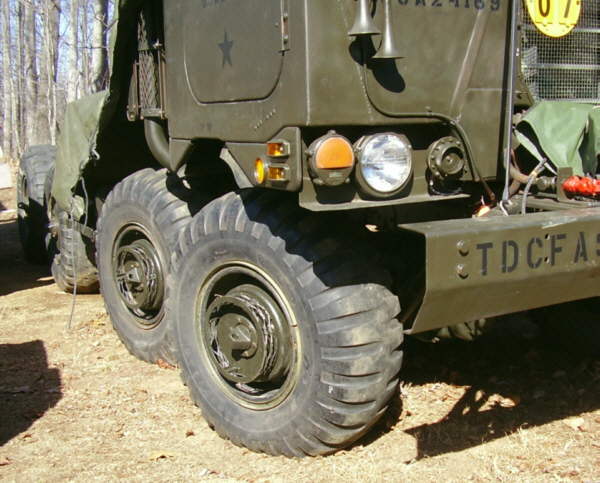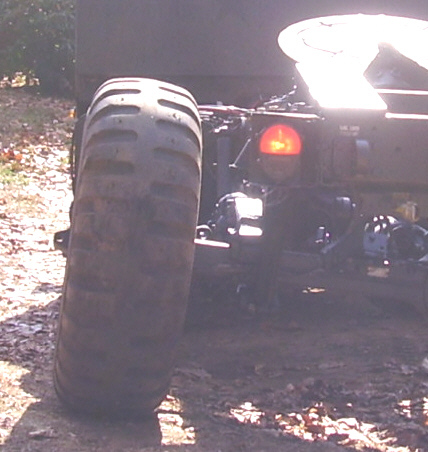Question XM757 Goodyear 16-20 f
XM757 Goodyear 16-20 f
QUESTION: Hi,
In the process of restoring a 1960's military vehicle, I have run into a problem finding good original equipment tires for it.
The 16/70-20 tubeless, 10-ply, bias ply low pressure tires were exclusively made for this series of vehicles and less than 500 trucks were delivered to the US Army.
After the vehicles were surplussed at the end of 1980's, the tires were apparently no longer made.
The NSN for the tire was 2610-00-886-1262.
My question is, how can I find construction details, load capacities etc for this tire?
Thanks,
Bjorn
ANSWER: Bjorn,
First, I would document every marking on the sidewall of the tire. Photos might be the best way to do this - and then record the wording in case the photos are difficult to read. Do both sides of the tire, in case there is a difference (and it is likely they are different.)
Then I would approach Goodyear to see if they can shed any light on the subject.
The tire size is unusual and not standard, especially for that time frame.
Perhaps it might be fruitful to search through military procurement documents of the era to see if you can find a description.
---------- FOLLOW-UP ----------
 XM757 BF Goodrich tire
XM757 BF Goodrich tire
QUESTION: Hi, hope it's okay to ask more than one question. :-)
1) When producing a tire of a particular design for the military and several manufacturers are involved, do they share design information or are they on their own to meet the mil spec for that particular tire?
2) What's involved in designing a bias ply tire that has an almost flat tire-to-ground contact area?
3) Is there a marking on the tire that indicates when the tire was first produced as in first ever, besides the date code?
4) Is it only a coincident that this particular tire design was produced at a factory that specializes in aircraft type tires (Goodyear)?
5) What is special about a tire design that makes it possible to run it at low (30 psi) pressure on the highway?
6) All else being equal, which tire is safer to use after 20 years, a bias or a radial ply version of the same tire?
7) Comparing the two tires, flat top (BF Goodrich) or slightly rounded top (Goodyear), which is the greater accomplishment in a bias ply tire (see images)?
8) Does the top layer of a tire add to the strength or is it only protecting the supporting plies below and if so, how much weather checking can be tolerated?
9) If the role of the top layer (besides providing the tread pattern) is to protect the plies below, how much injury can be tolerated without weakening the tire?
10) Can weather checking be completely repaired with some vulcanizing agent?
Thanks,
Bjorn
AnswerBjorn,
You asked:
1) When producing a tire of a particular design for the military and several manufacturers are involved, do they share design information or are they on their own to meet the mil spec for that particular tire?
Typically, when specifications are issued for any product, the way to meet the specifications is up to each manufacturer to figure out. This applies to airplanes as well as tires.
Therefore, no design information is shared.
2) What's involved in designing a bias ply tire that has an almost flat tire-to-ground contact area?
That's sort of like asking how to make scrambled eggs. There's lots of different ways to get there and I don't think you want me to tell how to raise chickens so you can get the eggs.
Besides, the tires were probably designed to have LOW ground contact pressure - which is a whole lot different than even ground contact pressure (which is impossible).
3) Is there a marking on the tire that indicates when the tire was first produced as in first ever, besides the date code?
They didn't start using a standardized date code system until 1968. Up until it was mandated by the US government, each tire manufacturer had its own system (or lack of a system).
Plus, off road tires might not use the same date code system as highway tires - and it's quite possible that military tires would be exempt from the requirement.
4) Is it only a coincident that this particular tire design was produced at a factory that specializes in aircraft type tires (Goodyear)?
Probably not. The equipment to make tires is more a function of size than anything else. What vehicle the tire is going to be put on is more a function of the design - which can have many common elements with other types of tires. Not to mention that I'll bet there was a requirement that there be an on-site military quality control guy - and a plant making aircraft tires would have a guy already there!
5) What is special about a tire design that makes it possible to run it at low (30 psi) pressure on the highway?
Size compared to the load being carried. After all, passenger car tires are inflated that low - and truck tires could be too, if there wasn't a weight limitation on the overall truck. High pressure tires don't weigh as much for the amount of load they are carrying.
6) All else being equal, which tire is safer to use after 20 years, a bias or a radial ply version of the same tire?
Neither tire is safe to use after 20 years!
7) Comparing the two tires, flat top (BF Goodrich) or slightly rounded top (Goodyear), which is the greater accomplishment in a bias ply tire (see images)?
Only the BFG image came through, but I can give you the answer without them: There are different ways of accomplishing a task, and that's all that matters. Unfortunately, we don't know how the tires actually performed by looking at them.
8) Does the top layer of a tire add to the strength or is it only protecting the supporting plies below and if so, how much weather checking can be tolerated?
Let me put it this way: The tread sits on top of the plies - and the plies provide the structure for the tire - sort of like the way airplanes were made when they used fabric on the wings. The real structure was underneath.
The problem is that rubber deteriorates over time - mostly due to oxygen, but not 100% - and oxygen is going to permeate through from both the outside and the inside. After 20 years, the rubber has lost a considerable amount of its desirable properties - including it ability to adhere to the ply cord.
Weather checking is only the external indicator of the state of the rubber and tells you very little about what's inside if the tire hasn't been used much - and if it's still got plenty of tread left after 20 years, it has been used enough that weather checking would be a good indicator of the state of the rubber / ply adhesion.
9) If the role of the top layer (besides providing the tread pattern) is to protect the plies below, how much injury can be tolerated without weakening the tire?
If the plies are cut, the structure has been weakened. The amount of cuts is almost immaterial - except to say that if there are enough cuts - and they are deep enough - chunks of rubber will come off, and that's not a good thing.
10) Can weather checking be completely repaired with some vulcanizing agent?
No, it's an irreversible process.

